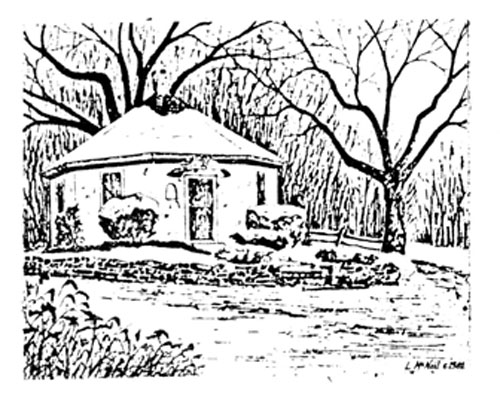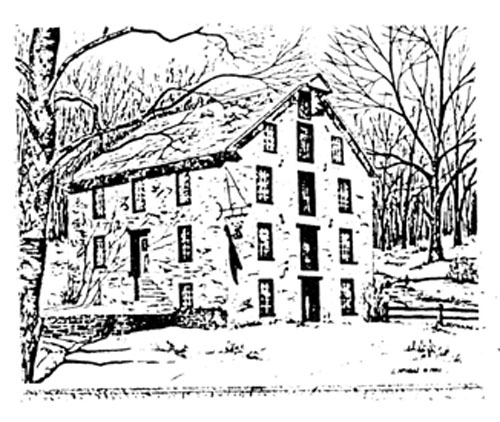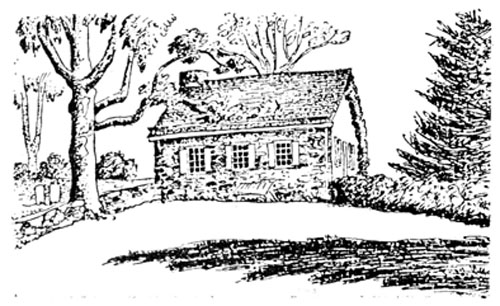|
Source: July 1982 Volume 20 Number 3, Pages 101–107
Notes and Comments "Tour Tredyffrin"
Anne H. Cook
Page 101
Top
Tour Tredyffrin
The tricentennial of the founding of Pennsylvania and Chester County by William Penn in 1682 was
celebrated in Tredyffrin on Sunday, May 16th when "Tour Tredyffrin" was sponsored by the Board of
Supervisors of Tredyffrin Township. The members of the Board of Supervisors are Paul W. Olson,
Chairman, Lee F. Seybert, Vice-Chairman, L. Clyde Barnes, Jr., William Scott Megargee III, Tracy C.
Massey, Joseph L. Pyle, Jr., and Donald C. Smith. Community representatives coordinating the event
were Mrs. Theodore Widing, Jr. and Mrs. George T. Cook.
The event was highlighted by a self-guided automobile tour of historic and modern-day sites,
scheduled for 2 to 5 p.m. As a guide to the sites, a map was printed in The Suburban and Wayne
Times. The Philadelphia Quartz Co. funded the printing of posters to publicize the tour and picnic
that followed it.
Many of the buildings on the tour are open only infrequently, if at all, to the public. Represented
were sites from varied periods of history, from the 18th century to the present, reflecting a
diversity of building types. Included were buildings used for educational, agricultural, religious,
domestic, industrial, and transportation uses.
An estimated 800 to 1000 persons participated in the tour, with individual sites visited by as many
as 400 or more people.
The following brief summary of each site gives a highlight of each building and its history. Sites
included on the National Register of Historic Places are indicated by an asterisk (*).
Page 102

Diamond Rock School
-
Blue Ball Tavern, on Old Lancaster Road in Daylesford, was a fine tavern, built about 1790 by Moses
Moore, and was the second Blue Ball tavern in the area. Accommodating travelers along the newly
constructed Philadelphia to Lancaster Turnpike, it was frequented by drovers taking their animals
to market. At the time of the Civil War, the inn was a recruiting place for militia, and known to
be a station on the Underground Railroad, bringing slaves to freedom. Runaways were hidden in
secret rooms above the kitchen or in the woodshed. Prissy Robinson, its renowned innkeeper, lived
here for a full hundred years, from 1787 to 1887. Some say ghosts haunt the place. The present
owners are Mr. and Mrs. Ronald E. Kehler.
-
Diamond Rock Octagonal School, on Yellow Springs Road north of Paoli, was "the first school of free
education in eastern Chester County". The octagonal one-room school house opened on September 21,
1818, one of many octagonal school houses erected in the early and mid-19th century. In an
architectural journal of 1853, it was pointed out that "the nearer in form we can approach the
circular the better ... the octagonal form serves better than the square and is preferable in every
way". Local residents built the school for a total cost of $260.93 on land donated by George
Beaver. The building was restored in 1917 to its original condition by the Diamond Rock Old Pupils
Association. It is maintained by the Association, of which William Fanus is president.
-
*duPortail's Quarters and the Federal Barn, in Chesterbrook, date from the Revolutionary period.
During the winter encampment of George Washington's forces at Valley Forge, General Louis
duPortail, a French engineer who planned the defenses at Valley Forge, used this house as his
quarters. The original portion of the house was built by John Havard, a Welshman. It is believed
that the room occupied by duPortail was above the original kitchen, in the rear of the present
building. Some years later the drawings made by him for the defenses were found in the rafters of
this room. The house is now in the process of restoration. Adjacent to it is the Federal Barn,
presently being stabilized and restored under a grant from the Pennsylvania Historical and Museum
Commission, with matching funds from the Chester County Commissioners, Tredyffrin Township
Supervisors, The Fox Companies, and private donors. This "signed" stone bank barn has a 1792
datestone in its original portion, while inscribed in the interior plaster of the west wall gable
in large script is "The Federal Barn 1792" and, nearby, the long-hand inscriptions "Jonathan Moor
his work" and "John Hamer 1792". A second section, doubling the size of the barn, was built between
1830 and 1850. These properties are owned by Duportail House Inc. and The Federal Barn Restoration
Association.
Page 103

Great Valley Mill, Drawings by Linda McNeil
-
Great Valley Mill, on North Valley Road north of Paoli, is an outstanding example of a typical
southeast Pennsylvania mill and reflects a long tradition of a mill building form not usually found
outside this area. It was founded in 1710 or earlier by Thomas Jerman, a Welsh settler who
purchased land totaling 300 acres from William Powel in 1701. Jerman built one of the very earliest
mills in Chester County, and one of the first to operate outside William Penn's monopoly. During
the Valley Forge encampment of 1777-78, the mill played a key role in supplying flour to
Washington's troops. It is known that one of Washington's aides, Thomas Bones, later married
Susannah Rowland, the daughter of the miller at the time of the encampment. In 1859 the mill was
rebuilt to replace the much smaller stone custom grist mill that measured only 30 x 14 feet. Plans
used for its design were derived from those found in the book written in 1795 by Oliver Evans, The
Young Millwright and Miller's Guide. Evans is credited with the development of technology that
revolutionized milling. A mill on this site was in continuous operation for almost 250 years. The
present owners are Mr. and Mrs. W. Thomas Kelly.
-
Jenkins Arboretum and Wildlife Sanctuary, on Berwyn-Baptist Road in Devon, is a 46-acre nature
preserve. The twenty acres on which the Arboretum was first planned were formerly the home of H.
Lawrence Jenkins, and were donated by him as a memorial to his wife, Elizabeth Phillippe Jenkins.
In 1971 Mrs. Louisa P. Browning, owner of the adjoining tract, gave her 26 acres of land to the
Foundation that had been established, doubling the size of the park. A loghouse, restored by R.
Brognard Okie,will be developed to become a part of the Arboretum. The Jenkins Arboretum is located
in a remnant of southeastern Pennsylvania's hardwood forest, with oak, tulip tree, hickory, beech,
birch, and maple. The shrubs there huckleberry, and trailing arbutus. The site is a public park.
Page 104

Old Eagle School
-
Old Eagle School, on Old Eagle School Road in Strafford, is the oldest standing school building in
Tredyffrin. It was built in about 1765-67 by German Lutheran settlers, and served as a place for
both church and school. The school was bi-lingual, German and English. The adjacent graveyard has
both pre-Revolutionary graves and graves of Revolutionary War soldiers, including that of Captain
John Davis, a local Revolutionary hero. The school is an outstanding example of an early school
house and was restored in 1909 by R. Brognard Okie. The History of the Old Eagle School by Henry
Pleasants was published in the same year. The school grounds are maintained by local residents and
the Trustees of Old Eagle School, of which Frederick Billups is the current president.
-
Southeastern Pennsylvania General Mail Facility, on West Valley Road, is a two fold operation: a
Management Sectional Center and a General Mail Facility. The Management Sectional Center encompasses
1,680 square miles of Zip Code areas 189, 193, and 194. The Sectional Center manager and his staff
are administratively responsible for 159 associate post offices in the area. Staffed by 500
employees who operate on a 3-tour, 6-day per week basis, the facility processes over one and a half
million pieces of mail on a daily basis. The facility was opened in 1980 and is a part of the United
States Postal Service.
-
Strafford Railroad Station has served as the railroad station for Strafford since 1887. It previously
was the station at Wayne until moved to Eagle (renamed Strafford in 1887) in 1884. From 1887 to 1948
the building was also used as Strafford's post office. According to local tradition and many written
articles, prior to its use as a station the building was part of the Centennial Exposition held in
Fairmount Park in 1876. The wooden two-story building is highlighted by decorative stick work that
gives the appearance of structural function. The decorative motifs display unusual carpentry skill and
most of them have been well preserved. This interesting building has been nominated for the National
Register. Its owner is the National Railroad Passenger Corporation,
Page 105

Valley Friends Meeting
-
Valley Friends Meeting, on Old Eagle School Road north of Swedesford Road, was started by Lewis
Walker, an early settler. Before 1730 the Valley Friends met at his home. In 1731 a log meeting
house was built in the southeastern corner of the graveyard, on land donated by Walker, This
meeting house is believed to have served as a military hospital during the encampment at Valley
Forge. The log structure was destroyed by fire in 1870, and a two-story stucco/stone building, with
a wrap-around porch and a cross gable roof, was erected on the site in 1871. This Victorian era
building still serves today as the meeting house,
-
VanLeer-Curwen Log House, on the Conestoga High School grounds, is an excellent example of a rarely
surviving type in Chester County. Carefully restored by Conrad Wilson and high school students in
the early 1960's as part of a course in American History and Culture, the building was cleaned out
and furnished under the direction of Mildred Kirkner of the Tredyffrin Easttown History Club for
this occasion. Built some time between 1790 and 1820, the house may have first been used as an
animal shelter. By 1820, however, it was used as a residence. The building is owned by the
Tredyffrin-Easttown School District,
-
*Weatherby-Hampton Log House, on Irish Road in Berwyn, is a charming early log house, estimated to
have been built about 1704, and is an example of the kind of home built at the time Penn
established his new colony. As the 17th century closed and the 18th century began, this kind of
building dotted the rural landscape. The house has a steeply pitched gable roof, small square
windows, and a massive fireplace typical of colonial vernacular architecture. All the window frames
are pegged, the floors are made from wide, heavy oak planks, and the staircase is narrow and steep.
This banked house with two wings is an excellent example of early log design. It is said to have
been built on an old Indian burial ground, and is described in the book Log Cabins in America, by
C. A. Weslager. The property is owned by Mrs. Mildred Erdman.
Page 106
"Tour Tredyffrin" also featured a "bring your own" picnic at the Conestoga High School grounds,
beginning at 3:30 in the afternoon and lasting until about seven o'clock, with a free orange
beverage courtesy of MacDonald's. Mac Sinkler, pianist, provided lively music for the picnickers,
and at 5:30 the Berwyn Fire Company exhibited two of its vehicles. (Anne Cook)
Top
Progress in Registration of Strafford Station
Word has been received from Susan M. Zacher, National Register Coordinator of the Pennsylvania
Historical and Museum Commission, that the "completed historic resource form" submitted for the
Strafford station (as reported in the previous Quarterly) has been received by the Bureau for
Historic Preservation. "From the documentary evidence," she reported, "the resource appears to meet
the National Register criteria and to have a nomination priority as established by the Historic
Preservation Board."
The next step, the completion of the National Registration nomination, has now also been completed
and submitted.
Top
A Further Note on Recreation in the Last Half of the 19th Century
Since the article on recreation in the latter half of the nineteenth century appeared in the
previous issue of the Quarterly, it has been noted that mention perhaps should also have been made
of cycling.
With the introduction of the bicycle into the United States at the Centennial Exposition in 1876,
it became quite a popular sport in the last quarter of the century, and a number of wheelmen's
clubs were formed.
As a case in point, here is an item from the West Chester Daily Local News for March 28, 1887. It
appeared under the heading "Fifty Bicyclists at Paoli".
"Ezekiel Shoemaker, of Paoli, has leased for the next season the Paoli Inn property. This property
was used by the Misses Newbold as a summer boarding house. This is expected to be the headquarters
for bicyclists next season, as all those traveling along the road last season stopped at
Shoemaker's. Mr. S. has already received notice that a company of fifty bicyclists, representing
the clubs of New York, Boston, Washington and Philadelphia will stop with him for dinner about the
middle of May. They will make an overland trip from Philadelphia, making a southern tour of four
weeks. When they arrive at Paoli, the letter stated that the wheelmen would all take a ride over
the massacre grounds."
Page 107
Top
Local Student Sings with Pavarotti
John Cooper, a ninth grade student at Valley Forge Junior High School,was one of fourteen youths
selected to sing with the famous tenor Luciano Pavarotti in "La Boheme" at the Academy of Music
in Philadelphia last April. His selection was made following special auditions.
John gained his first singing experience in the third grade at New Eagle Elementary School under
the guidance of his music teacher, Sue Clayton. At Valley Forge he also plays clarinet in the
school band and orchestra. Other interests include model railroading, photography, and computer
study.
He also sings second alto with the Philadelphia Boys Choir, and this spring toured England with the
group in conjunction with the 300th birthday of Philadelphia. His father is a singer with the Savoy
Company, for which his mother is a costume designer.
Top
VanLeer Cabin Consultant Honored
One of eighteen persons recently named to receive Honor Awards from the National Trust for Historic
Preservation was G. Edwin Brumbaugh. The award was made in recognition of "a 60 year career in
preservation that has included writing books, lecturing, and restoring many major public buildings
such as Independence Hall in Philadelphia".
Brumbaugh served in an advisory capacity to the Tredyffrin Easttown History Club prior to the
restoration of the Van Leer Log House.
Top
Thank you, Molly
After serving more than ten years in the position, Molly TenBroeck resigned as secretary of the
Tredyffrin Easttown History Club in May. Her "retirement" is well earned and well deserved. We
now have two secretaries, as shown on the first page, Elizabeth Weaver assuming the duties of
recording secretary, and Elizabeth Rumrill those of the corresponding secretary.
|



